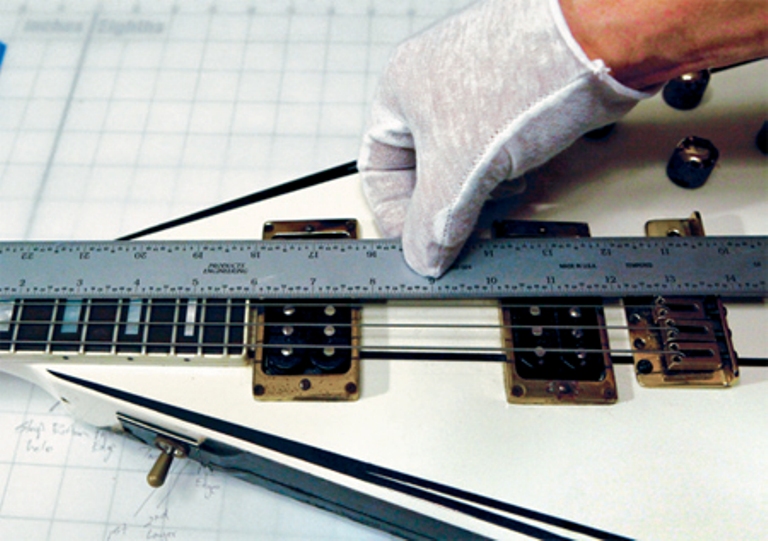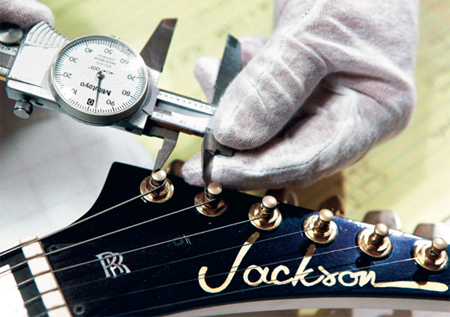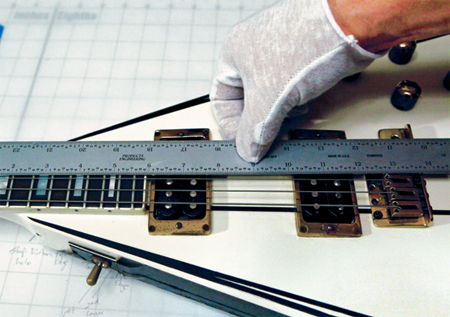Randy Rhoads Condorde Guitar: Flying High Again

In honor of Randy Rhoads, who graces the cover of the July issue of Guitar World, here's the story behind the limited-edition reproduction of Rhoads’ legendary Concorde guitar.
In 1980, an up-and-coming young metal guitarist paid a call on an up-and-coming guitar builder. The two would soon make history, both individually and collectively.
The guitar player was Randy Rhoads, then at the start of his legendary, although tragically brief, career. The guitar maker was Grover Jackson, whose surname would soon become known as one of the top metal guitar brands, but who was then still at another guitar company, Charvel.
Working closely with Rhoads, Jackson created what would become one of the most revered instruments in all of metaldom: the asymmetrical Flying V–shaped Jackson/Rhoads Concorde.
It was the dawn of a new era in metal. Rhoads’ trailblazing work with Ozzy Osbourne was bringing virtuoso classical playing techniques and modalities into the rock guitar vocabulary, setting the stage for the shred movement of the Eighties. This bold new playing style demanded a new kind of electric guitar, an instrument optimized for the daunting performance skills that Rhoads introduced to rock.
Jackson was one of the first luthiers to answer the call for instruments that met the requirements of this new breed of player. Likewise, the Concorde helped establish the look and feel of the “pointy guitar” aesthetic that dominated Eighties shred and hair metal. It was also the first instrument ever to bear Jackson’s name on the headstock.
The Concorde made headlines once again wirth the recent introduction of the Randy Rhoads Relic Tribute Model, a meticulously detailed limited-edition reproduction of the historic guitar that Rhoads rode to rock immortality. The project was spearheaded by Fender Musical Instruments, which owns the Jackson brand, to celebrate the 30th anniversary of the instrument’s creation and, with it, the birth of Jackson Guitars.
Get The Pick Newsletter
All the latest guitar news, interviews, lessons, reviews, deals and more, direct to your inbox!
Limited to just 60 specimens, the guitar carried a list price of $12,619.56, a figure that reflects Rhoads’ birth date: 12/6/1956. While other Randy Rhoads Concorde models have been produced in the past, this is the first one to reproduce the exact dimensions and design of the original. That’s because this is the first one to be based on a careful analysis of Rhoads’ original instrument.
“It’s our small way of paying homage to Randy’s timeless legacy, not only as an influential metal guitarist but also as a groundbreaking designer,” says Jackson marketing director Nick Bowcott, who worked closely with the Rhoads family on the new guitar.
“While the Concorde has been built in limited quantities before, the original had never been examined, let alone meticulously measured. In fact, one public showing aside, this legendary guitar has been kept under lock and key by Randy’s mother, Delores, in an undisclosed location ever since his death.”
Shortly after Rhoads’ untimely passing in 1982, his family regained possession of the guitars and amps he had played, and even the stage clothing he’d worn, during his tenure with Ozzy. Since that time, these items have been kept in storage and taken out of their cases only for rare and select instances of photo and video documentation.
The family gave its approval to the Fender project, and in late November 2009, Bowcott, Jackson Custom Shop master builder Mike Shannon and relic craftsman Chip Ellis made a pilgrimage to Musonia, the North Hollywood music school owned and operated by the Rhoads family in Randy’s time and to this very day. Three of Randy’s guitars, including the coveted Concorde, were brought from their secret storage location and placed on a table inside the school.
“When we opened the cases, there was a faint smell of Randy’s cologne and cigarettes,” says Kelle Rhoads, the late guitarist’s brother. “And you could see all the spare hardware that Randy kept in there. He had enough in each case to do considerable repairs on the road — replacement parts, tools, extra straps. It was like opening a time capsule, as if the guitars themselves weren’t enough.”

The Concorde was scoped out with curatorial precision and white-glove reverence. Without dismantling the instrument, Shannon and his associates measured every dimension, angle and component. They also traced the body and neck shapes and took extensively detailed photographs of the instrument. “It blew those guys away,” Kelle recalls.
“They were like, ‘We’re so honored and humbled that you’re sharing this with us. We just thought you were gonna let us see the guitar for 10 minutes.’ We let them have as much time as they wanted. It took them about four hours.”
Armed with this data, the team repaired to the Jackson Custom Shop and set about recreating the original Concorde in all its battered glory. To the casual viewer, what’s most immediately noticeable about the instrument is its asymmetrical V-shaped body and rakishly angled six-on-a-side headstock, which became the template for the ubiquitous “hockey stick” headstocks of metal guitardom. The Concorde’s body is, of course, a take-off on Ted McCarty’s groundbreaking design for the Gibson Flying V, first introduced in 1958. But the original Flying V headstock is an angular variation on the traditional three-and-three headstock, nothing like the Concorde’s quintessentially Eighties design.
So where did that headstock shape come from? And why make the body asymmetrical, rather than even-sided, like the Gibson original? Numerous theories have been advanced. But Kelle says the truth lies with the name of the instrument itself. In the early Eighties, when Rhoads conceived of the guitar, the Concorde supersonic airline was just coming into vogue.
The passenger jet cut the time of a transcontinental flight by about two thirds, but a ticket cost a small fortune. However, Randy found himself onboard a Concorde flight from London to New York on one of his Christmas vacations from Osbourne’s band.
“Randy was afraid of flying,” Kelle says, “so as a Christmas present, Ozzy and Sharon Osbourne told him, ‘We’re going to let you fly home on the Concorde,’ thinking that the shorter flight might make things easier for him. And afraid of airplanes as Randy was, it was quite an experience for him. It really affected him profoundly.
"He flew from London to New York on the Concorde and then took a regular flight from New York to LAX. He kept talking about how nice the silverware and china were, and the stemware was all crystal. And how, when the plane lifted off, the cockpit kind of looked like a guitar headstock. That’s how he came to name that guitar the Concorde and came up with that headstock design. And if you turn the guitar body a certain angle — toward 10 or 11 o’clock, face-on, it really looks like the Concorde in flight.”
Recreating this historic instrument was a labor of love for Mike Shannon, who performed some work on the original model back in 1980 when he was working with Grover Jackson at Charvel. He actually got to meet Rhoads at that time. “My main thing was woodworking, although I also worked in paint, buff and polish, and final assembly,” Shannon says.
“I was there for the design of all the neck-through-body guitars, like the Rhoads and the Soloist. We did things on thin router shapers and band saws. That’s real woodworking. Randy came by the shop several times. Usually, he would come in later on in the evening, when most people were gone. I just took a quick opportunity to meet him when he came through the woodshop. I believe it was the first time he came through there, before we made the guitar. Randy was probably one of the sweetest guys out there.”
In examining the original Concorde, Shannon made several interesting discoveries. For one, the body contour is slightly different than previously released Rhoads models. “Also,” he says, “the black headstock and pinstriping have some metallic purple in them. It’s not a pure black. I had no memory of that from the original. Also, the truss-rod cover is ebony, with the initials RR inlaid in mother-of-pearl, which is impossible to tell from any photos of the guitar you’ve ever seen. The initials are very similar to the Rolls Royce emblem and very much like Randy’s RR ring, which a lot of fans know.”

Along with establishing the sharp-angled look of Eighties metal guitars, the original Concorde set the trend for neck-through-body designs. “It has a four-piece maple center body blank,” Shannon says. “Also, it’s made of big-leaf maple, which is much lighter than the hard rock maple we used in earlier Randy Rhoads models. When I picked up Randy’s guitar, I realized, Hey it’s not that heavy. Duh, it’s big-leaf maple.”
Of course, Shannon paid careful attention to the neck shape and dimensions. “The neck was fairly thick and round,” he says, “similar to the Les Paul bat shapes, but it had slightly different dimensions. It was still 1 11/16 at the bone nut. But at the butt, by the 22nd fret, it was 2 3/16ths, which is not standard for the guitars we do today.
"When the Floyd came along, we started to make the neck a little wider, for string spacing or whatnot. But back then there was no Floyd Rose bridge yet. The guitar has a brass trem-style bridge that we used on Charvel bodies.”
Even the flaws on the original instrument are lovingly reproduced on the new tribute model. “On the original body, you can see the lamination joins through the finish,” Shannon says. “And there are also 21 dowel plugs you can see through the finish.”
The plugs are a vestige of the ad hoc techniques that Jackson and his team used to rout out pickup cavities and similar body orifices. Because this was a one-off custom guitar, they didn’t cut patterns to guide their pin router; they simply screwed a wooden straight edge onto the body, unscrewed the straight edge after routing was complete and later filled in the screw holes with dowels. All 21 of these minor blemishes are reproduced on the Jackson Randy Rhoads Relic Tribute guitars. This being Randy Rhoads, every detail is sacred.
The instruments were even subjected to heat and cold treatments to reproduce the expansion and contraction of wood over the years, which has caused the dowels to separate slightly from the body. Afterward, the guitars went to Chip Ellis, who meticulously reproduced all the playing wear, dings and dents of the original, a service he’d earlier performed on Fender’s limited-edition Eddie Van Halen Frankenstein relics. Shannon says, “Chip was tripping out when he went to see the original guitars with me. He was probably 10 years old when those were made.”
As part of the reliquing process, Shannon had to reproduce the layers of black electrical tape covering the back of the white body. “The guitars were taped up for aesthetic reasons,” Kelle explains. “It’s something that Sharon Osbourne wanted done for the Ozzy [Diary of a Madman] tour, the one with the medieval castle stage set. When the musicians were standing on the stage, turned backwards, you couldn’t tell they were guitars. She didn’t want the audience to see any equipment.”
So how well did the Jackson Custom Shop do its job? So well that Kelle and his sister, Kathy, had to do a second take when they first saw one of the recreations at the January 2010 NAMM Show, where the model was introduced.
Kelle recalls, “It was so perfect that, for a moment, my sister and I said, ‘Hey, they stole Randy’s guitar!’ ”
“It holds its own purely as a playable guitar. It’s really cool for the traveling musician – you can bring it on a flight and it fits beneath the seat”: Why Steve Stevens put his name to a foldable guitar
“Finely tuned instruments with effortless playability and one of the best vibratos there is”: PRS Standard 24 Satin and S2 Standard 24 Satin review









